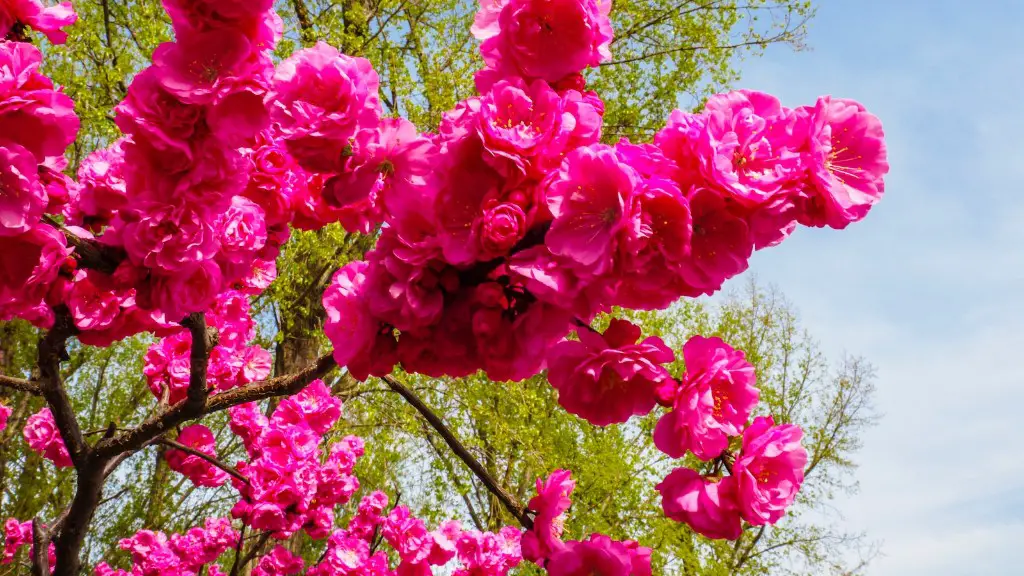The Japanese cherry blossom tree, commonly known as sakura, is a popular ornamental addition to many gardens and cityscapes throughout the world. But when is the best time to plant this gorgeous tree in your garden? Despite their fragility and popularity, Japanese cherry blossom trees are surprisingly easy to maintain and care for. With the right planting and ongoing care, their blooms will bring delight to your garden for many years to come.
For the best results when planting Japanese cherry blossom, you must understand the blooming cycle of sakura. Cherry blossoms typically bloom for about two weeks in the late spring or early summer, before the flowers start to fall and the leaves become evident. Prior to blossoming, the trees enjoy a period of growth, during which their roots take hold of the soil and a deep root system is established. Therefore, planting the tree while the flowers are in bloom is a bad idea; by the time the root system has grown enough to break through to the surface and the blossoms, the blooms will have already begun to fall.
One of the surest methods to ensure that your sakura will bloom on time is to plant the tree in the winter. During this time, the tree will develop its root system and start to become established. After several months, the tree will be ready to start producing its beautiful blooms, which gives you plenty of time to prepare your garden for their arrival. Additionally, planting the tree in winter ensures that the temperatures are cool enough for the roots to take hold and the soil will be free from any standing water which could hinder their growth.
When planting, it is essential to ensure the tree is not in direct sun for too long. Cherry trees prefer a partly shady spot and will thrive with four to six hours of direct sun a day. It is also important to pick the right spot to ensure that the tree has enough space to grow and spread its roots during its lifetime. Finally, be aware that Japanese cherry blossoms are quite sensitive and will not tolerate salty air or strong winds. In areas such as beach-side locations, near salty water or in windy areas, you may have to look into appropriate kinds of protective covers to guard the tree.
If the tree is planted in the right location and nurtured with careful attention and love, your cherry blossom tree should bloom year after year. When it comes to caring for the sakura, mulching around the tree, removing dead leaves, and applying fertilizer during spring and summer are the most important elements of maintenance. This will not only help the tree to remain healthy and strong, but also encourage more blooms. Pruning the branches is also an important part of caring for a Japanese cherry blossom tree, and you should aim to trim away any excess foliage on an annual basis, or when you notice the growth becoming too dense.
With these tips, you should now be well on your way to successfully planting your Japanese cherry blossom tree. You can soon look forward to a cascade of pale pink or white flowers blooming in your garden, filling your space with beauty and cheer.
Container Planting
If you have space restrictions and have decided to grow a sakura tree in a container, you should to decide on the right container for your blossom. A bigger pot will give the roots plenty of room to grow, so opt for large containers that are at least 15” deep and 20-24” in diameter. And while a light potting mix of 70% compost and 30% vermiculite should be just enough to provide your tree with the support it needs.
When tending to your potted cherry blossom tree, it is important to keep a regular watering schedule depending on the humidity and temperature outside. Although sakura trees prefer well-draining soil, make sure to gently water the soil when it is dry, and avoid leaving your tree in soggy conditions. As with any tree planted in the ground, avoid over watering your potted blossoms, as this can affect their growth and health.
Fertilizing
Another important aspect of caring for your Japanese cherry blossom tree is fertilizing. Fertilizers are a great way to help your sakura tree develop an abundance of blooms, as organic compounds contained in the fertilizer help increase the nutrient intake and provide the tree with essential vitamins and minerals. Adding a layer of fertilizer every two months or so during the Spring and Summer is a great way to give the tree that extra boost during the most important times of its blooming cycle.
Tip for Cold Climates
For those living in areas with colder climates, fear not, Japanese cherry blossom trees can still survive in such climates when you give them the right amount of TLC and protection. During the colder months, it is recommended to layer the tree with hay or mulch for insulation and keep a regular watering schedule. Additionally, in areas with more than -10 degrees Celsius, it is best to cover the tree with a blanket to provide it with additional warmth.
Mulching
Mulching is an effective way to enhance the soil and condition of your cherry tree’s roots. Using a light mulch of three to four inches of compost or hay will help protect the tree’s roots and will aid with keeping a wide range of plant diseases at bay. This layer of mulch should be replaced a few times a year, or as needed, to keep it fresh and free from debris or fallen leaves.
Pruning
Pruning is essential for maintaining the health of your Japanese cherry blossom tree. This should be done annually, or when you notice the growth becoming too dense. Pruning involves removing diseased, dead, or damaged branches, as well as any dead flowers or foliage. This helps with improving the airflow in the tree, encourages new growth, and eliminates any potential disease or pests from taking hold. When pruning, it is important to use the right tools to ensure that the job is done correctly.


